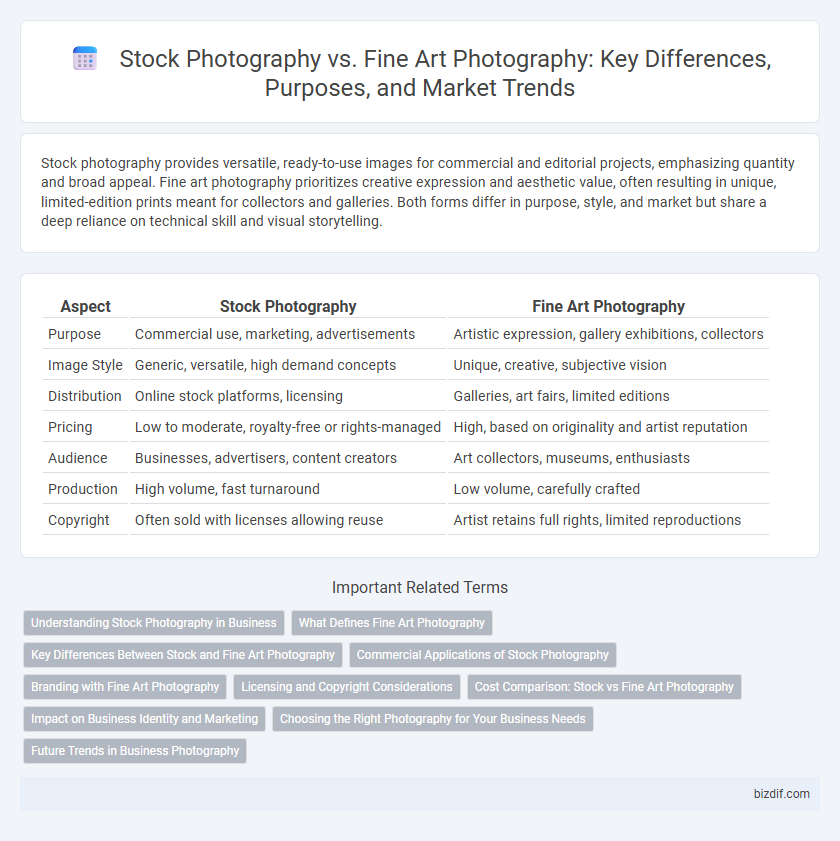Stock photography provides versatile, ready-to-use images for commercial and editorial projects, emphasizing quantity and broad appeal. Fine art photography prioritizes creative expression and aesthetic value, often resulting in unique, limited-edition prints meant for collectors and galleries. Both forms differ in purpose, style, and market but share a deep reliance on technical skill and visual storytelling.
Table of Comparison
| Aspect | Stock Photography | Fine Art Photography |
|---|---|---|
| Purpose | Commercial use, marketing, advertisements | Artistic expression, gallery exhibitions, collectors |
| Image Style | Generic, versatile, high demand concepts | Unique, creative, subjective vision |
| Distribution | Online stock platforms, licensing | Galleries, art fairs, limited editions |
| Pricing | Low to moderate, royalty-free or rights-managed | High, based on originality and artist reputation |
| Audience | Businesses, advertisers, content creators | Art collectors, museums, enthusiasts |
| Production | High volume, fast turnaround | Low volume, carefully crafted |
| Copyright | Often sold with licenses allowing reuse | Artist retains full rights, limited reproductions |
Understanding Stock Photography in Business
Stock photography serves as a valuable resource for businesses seeking affordable, high-quality images to enhance marketing materials and websites. It offers a vast library of pre-shot, royalty-free images categorized by themes, allowing companies to quickly find visuals that align with their branding needs. Utilizing stock photography reduces costs and turnaround times compared to commissioning custom shoots, making it an efficient choice for commercial projects.
What Defines Fine Art Photography
Fine art photography is defined by its emphasis on creative expression, conceptual depth, and artistic vision, often intended for display and emotional engagement. Unlike stock photography, which prioritizes commercial use and clear messaging for marketing or editorial purposes, fine art photography explores personal narratives, aesthetics, and unique perspectives. It often involves meticulous composition, lighting, and post-processing to evoke mood and provoke thought, making each piece a distinct, collectible work of art.
Key Differences Between Stock and Fine Art Photography
Stock photography prioritizes commercial use with high-volume, royalty-free images designed for marketing, advertising, and editorial projects, emphasizing versatility and quick accessibility. Fine art photography focuses on creative expression, originality, and aesthetic value, often produced in limited editions and suited for galleries or private collections. Key differences include purpose, intended audience, licensing models, and the emotional or conceptual depth conveyed through the imagery.
Commercial Applications of Stock Photography
Stock photography serves as a versatile resource for businesses by providing affordable and diverse images suitable for marketing campaigns, websites, and social media content. Its extensive libraries offer ready-to-use visuals that save time and production costs while ensuring consistent brand messaging. Commercial applications benefit from stock photos' scalability and legal clarity, as licensing agreements allow unrestricted use across various advertising channels.
Branding with Fine Art Photography
Branding with fine art photography elevates a company's visual identity by incorporating unique, artistically crafted images that convey emotion and storytelling, distinguishing the brand from generic stock photography. Unlike stock photos, which often appear impersonal and widely used, fine art photography offers exclusivity and a cohesive aesthetic that strengthens brand recognition and emotional connection with the audience. Investing in fine art photography enhances brand authenticity and positions the business as sophisticated and original in competitive markets.
Licensing and Copyright Considerations
Stock photography licenses typically offer non-exclusive, royalty-free usage rights that allow businesses and individuals to use images multiple times across various media without paying additional fees, while copyright remains with the photographer or agency. Fine art photography often involves exclusive or limited edition licenses with stricter usage terms, preserving the artist's control over reproduction and distribution to maintain the work's value and uniqueness. Understanding the distinctions in licensing agreements and copyright enforcement is essential for legal compliance and protecting intellectual property in both stock and fine art photography markets.
Cost Comparison: Stock vs Fine Art Photography
Stock photography generally offers more affordable image licensing options, with prices often ranging from a few dollars to under a hundred per photo, making it cost-effective for commercial use. Fine art photography commands higher prices, frequently starting at several hundred dollars and reaching into thousands for limited editions or original prints due to its artistic value and exclusivity. Budget-conscious buyers prioritize stock photography for volume and variety, while collectors invest in fine art photography for unique, high-quality pieces with potential appreciation.
Impact on Business Identity and Marketing
Stock photography offers businesses a cost-effective way to enhance marketing materials with diverse, high-quality images that support brand messaging and boost visual appeal across platforms. Fine art photography provides a unique and personalized aesthetic that can elevate brand identity, fostering deeper emotional connections and distinguishing businesses in competitive markets. Integrating carefully selected fine art images or exclusive stock collections strengthens brand storytelling, increases engagement, and enhances overall marketing effectiveness.
Choosing the Right Photography for Your Business Needs
Stock photography offers a vast library of affordable, ready-to-use images ideal for businesses needing quick visual content that appeals to broad audiences and supports marketing campaigns. Fine art photography provides unique, artistic images that convey a distinctive brand identity and can elevate a company's aesthetic through personalized, high-quality prints or digital showcases. Selecting the right photography depends on the business's goals, budget, and desired emotional impact, with stock images suited for scalability and fine art favoring exclusivity and storytelling.
Future Trends in Business Photography
Future trends in business photography reveal a growing convergence between stock photography and fine art photography, driven by demand for more authentic and customizable visual content. Advances in AI-powered image curation and enhanced digital platforms enable photographers to offer unique, high-quality visuals that resonate with brand storytelling and consumer engagement. The rise of sustainable practices and immersive formats like AR and VR are also reshaping commercial photography, blending artistic expression with strategic marketing needs.
Stock Photography vs Fine Art Photography Infographic

 bizdif.com
bizdif.com